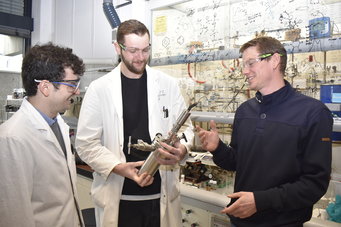The authorities will inspect construction sites on both sides of the border between 15 and 19 April to ensure employers are aware of their health and safety obligations – with a focus on reducing the risk of falls and work-related psychosocial hazards.
WorkSafe Victoria and SafeWork NSW will host a free Trade Breakfast at Dahlsens Albury Wodonga on Friday 12 April to discuss construction hazards and how to ensure worksites are inspection ready ahead of the blitz.
WorkSafe Director of Construction and Earth Resources Matt Wielgosz said proactive inspections were a key part of boosting safety in the construction industry.
“Since the start of last year, there have been 16 fatalities in construction, six of these resulted from falls from height,” Mr Wielgosz said.
“Construction workers go to work each day thinking ‘I won’t fall, I know what I’m doing’, but the fact is construction workers are falling and dying or suffering serious injuries right here in Victoria.”
“We’ll be reminding employers of their obligations to do everything possible to reduce the risk of falls – such as working on the ground where possible, or using safety protection such as complete scaffolding, guard railing and void covers.”
Construction workers accounted for almost a third of all Victorian workers injured in falls from height, making up 489 of the 1,534 injury claims accepted by WorkSafe since January 2023.
During that time, WorkSafe has accepted a total of 2,610 claims from workers seriously injured in the construction industry, including 54 in the Ovens Murray area.
The blitz will also see inspectors talk to employers about their obligations to address psychosocial hazards that could create a risk to health and safety, including bullying and fatigue.
SafeWork NSW Regional Director Construction Service Laurence Richey has highlighted the important role employers and business owners play in creating a mentally healthy work environment.
“SafeWork NSW has noticed an increased number of psychosocial hazards in the workplace, such as extreme workload and bullying, and reducing these numbers is a major focus for us as a regulator,” Mr Richey said.
“Business owners must ensure they are creating safe, healthy, and productive workplaces. This involves identifying and managing workplace risks that could potentially result in psychological harm to employees.”
“Continued economic pressures, such as inflation and supply chain disruption have sadly seen many businesses overlook the health, safety and wellbeing of workers. Businesses must not put productivity or profit above workers safety.”
Free Trade Breakfast
When: Friday 12 April, 7-9am
Where: Dahlsens Albury Wodonga, 58 – 98 Bennu Circuit, Lavington NSW 2640
To prevent falls from height employers should implement the highest possible measures from the five levels in the hierarchy of controls:
- Level 1 Eliminate the risk by, where practicable, doing all or some of the work on the ground or from a solid construction.
- Level 2 Use a passive fall prevention device such as scaffolds, perimeter screens, guardrails, safety mesh or elevating work platforms.
- Level 3 Use a positioning system, such as a travel-restraint system, to ensure employees work within a safe area.
- Level 4 Use a fall arrest system, such as a harness, catch platform or safety nets, to limit the risk of injuries in the event of a fall.
- Level 5 Use a fixed or portable ladder, or implement administrative controls.
To prevent work-related mental injuries, employers should:
- Promote a positive workplace culture that encourages trust, respectful behaviours and quality communication.
- Consult with employees when identifying and assessing any risks to their psychological health and determining the appropriate control measures.
- Implement policies and procedures for reporting and responding to psychosocial hazards such as workplace trauma, bullying, interpersonal conflict, violence and aggression; and reviewing and updating risk controls following any incidents.
- Regularly ask employees how they are, encourage them to discuss any work-related concerns and, where required, implement suitable support and controls.
- Have systems in place for workforce planning and workload management to ensure that employees have sufficient resources and a realistic workload.
- Develop skills for leaders through coaching, mentoring and training to improve the support of employees.
- Seek and act on feedback from employees during any organisational change process.
- Inform workers about their entitlements if they become unwell or unfit for work.
- Provide appropriate and confidential channels to support workplace mental health and wellbeing, such as Employee Assistance Programs.







